Saints of the Day
 |
 |
 |
 |
 |
 |
 |
Bl. Gobert of Aspremont - August 20
Biographical selection:
Blessed Gobert of Aspremont or Apremont (c.1187-1263) was a Count, a Crusader and a monk. He was a man who all his life was a warrior with the soul of a monk, and at the end of his life he died a monk in the Cistercian Abbey of Villers-en-Brabant.
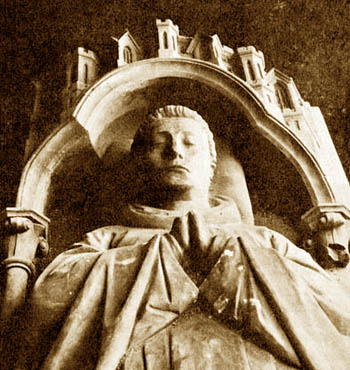 Gobert was the son of Godfried, Count of Aspremont in Lorraine and Elizabeth of Dampière. He and his brother Jean received an excellent formation. The two boys were strong, handsome and very dignified and refined in manners. Their father Godfried, observing the tendencies of his sons, directed Gobert to follow the military path and become the next Lord of Aspremont and his brother Jean to enter the priesthood; he became the Bishop of Metz.
Gobert was the son of Godfried, Count of Aspremont in Lorraine and Elizabeth of Dampière. He and his brother Jean received an excellent formation. The two boys were strong, handsome and very dignified and refined in manners. Their father Godfried, observing the tendencies of his sons, directed Gobert to follow the military path and become the next Lord of Aspremont and his brother Jean to enter the priesthood; he became the Bishop of Metz.
Gobert became known for his great military deeds; at the same time, he had a great fear and love of God and a strong devotion to the Virgin Mary. As a young knight, he entered the service of the King of France to combat the Albigensians, who were spreading their filthy doctrine. He distinguished himself for his bravery and intelligence in many combats. Afterwards, to thank God for His protection, he became a Crusader.
He went to Palestine in the expedition of Frederic II. However, as he approached the city of Saint John of Acre he learned that the Emperor had been excommunicated and that he planned to expel the Templars from that city to dominate it. Indignant, Gobert abandoned the Emperor and, followed by many soldiers, went to the Saint John of Acre.
The Templars and the inhabitants of the city, who already knew of Gobert's military prowess, received him as a messenger of Heaven. The defense of the city was organized and when Frederick II saw the banner of the Count of Aspremont waving atop of the walls of Constantinople, he understood that he should not try to take the city; he retreated and left the city alone.
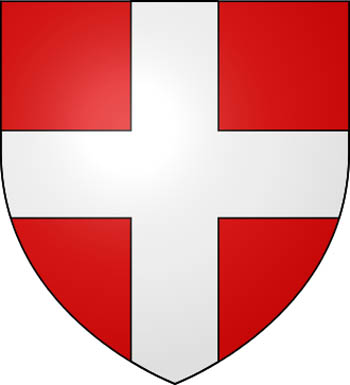 Having accomplished this mission, Bl. Gobert traveled to the Holy Places to venerate them. But he determined not to remain any longer in Palestine, where Frederick had united with the Muslims.
He returned to Lorraine in 1230, where he learned the Count of Bar had taken advantage of his absence to ransack his country and lay siege to the city of Metz. His subject called on him for his help. He rallied to their call, fought and defeated the Count, saving the city of Metz.
Having accomplished this mission, Bl. Gobert traveled to the Holy Places to venerate them. But he determined not to remain any longer in Palestine, where Frederick had united with the Muslims.
He returned to Lorraine in 1230, where he learned the Count of Bar had taken advantage of his absence to ransack his country and lay siege to the city of Metz. His subject called on him for his help. He rallied to their call, fought and defeated the Count, saving the city of Metz.
Sometime later, tired of the noise of the world, the Count of Aspremont retired to the Monastery of Villers-en-Brabant and received the Cistercian habit in 1237. He became as holy as a religious as he had been a great soldier; he was known for his austerity and deep devotion to the Virgin Mary.
Thus had the warrior and monk entered and win all the great combats of the Lord when God called His generous servant to his eternal recompense on August 20, 1263.
Comments of Prof. Plinio:
We have a magnificent example for us in the life of Bl. Gobert of Aspremont because he knew how to follow the will of God his entire life as a true servant of the Lord. He was a warrior and a monk. For us to understand well his life as a warrior, we should make some considerations.
First, his birth. He was from Lorraine (in northeastern France), which was a fief that was the last duchy of the Kingdom of Lothair, one of the grandsons of Charlemagne. From the Kingdom of Lothair came the Lotharingia, which became Lorraine, adding some small States on the borders between France and Germany.
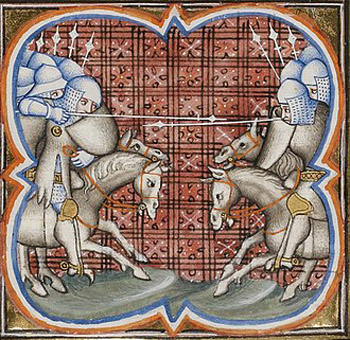 In those times, the boundaries of France and Germany were not defined as they are today. There were various small States that depended in certain matters on the King of France and in other matters on the Emperor of the Holy Roman German Empire. Those States were destined to mitigate the shock between the two powers – Germany and France. Of these States the most important was Lorraine.
In those times, the boundaries of France and Germany were not defined as they are today. There were various small States that depended in certain matters on the King of France and in other matters on the Emperor of the Holy Roman German Empire. Those States were destined to mitigate the shock between the two powers – Germany and France. Of these States the most important was Lorraine.
Lorraine was a duchy of high culture and civilization, célèbre for the great Saints it had given to the Church and would continue to give. Lorraine was a kind of synthesis of the French and German spirits. It was one of the most significant places in Europe. It was in Lorraine that Divine Providence chose Bl. Gobert to be born.
His father destined him to carry arms. As a warrior Gobert immediately involved himself in the great political-religious questions of his time. The first political question he had to face was the Crusade against the Albigensians.
The Albigensians were Gnostic and Manichean heretics. They had a dualist doctrine: They preached the existence of two equal gods – a bad god and a good god – who combated one another. But they considered that the good god was the Devil and the bad god was the True God. They were, therefore, idolaters of the Devil. They adhered to the most immoral and occult doctrine you could imagine.
 This doctrine had spread broadly throughout the south of France and was combated by the most salutary elements of France, among whom was the famous Count
Simon de Montfort, one of the preeminent figures of medieval Chivalry.
This doctrine had spread broadly throughout the south of France and was combated by the most salutary elements of France, among whom was the famous Count
Simon de Montfort, one of the preeminent figures of medieval Chivalry.
Since the King of France – with the support of the Holy See – had declared a Crusade against the Albigensians, as a warrior Bl. Gobert placed his sword at the disposition of the King of France and victoriously fought against the Albigensians. Actually the Albigensians were destroyed.
In the south of France today there are still some small remnants of the Albigensians. It is a curious characteristic of Europe that such heresies refuse to die. There still remain some small drops of Albigensians, which, had France had an ultramontane government, would have dried up immediately with the greatest vigor.
After that combat, Count Gobert decided to take part in the Crusade and, with that insouciance proper to the spirit of the medieval knight, he enlisted in the crusade led by Emperor Frederick II. Frederick II was an extremely bad man, a traitor to Christian Civilization and was excommunicated by the Pope. It was only when he arrived at Saint John of Acre that Blessed Gobert was informed that the Emperor had been excommunicated.
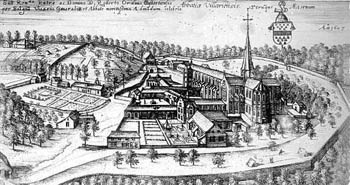
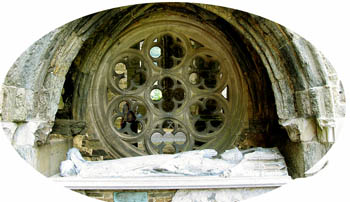 He also was informed that the Emperor wanted to destroy the Templars, who at that time were a very good religious Order of warrior-monks. In view of this, he broke with the Emperor and organized the defense of the city against him. He defeated the Emperor, that is, the Emperor could not take the city of Saint John of Acre, which at that time was the principal stronghold of the Catholic forces in the Holy Land.
He also was informed that the Emperor wanted to destroy the Templars, who at that time were a very good religious Order of warrior-monks. In view of this, he broke with the Emperor and organized the defense of the city against him. He defeated the Emperor, that is, the Emperor could not take the city of Saint John of Acre, which at that time was the principal stronghold of the Catholic forces in the Holy Land.
He went on to venerate the Holy Places in Jerusalem but he did not want to remain there because he was not a great feudal lord – he was a medium feudal lord – and did not have the necessary troops to efficiently fight against the disgusting alliance that the Emperor had made with the Muslims. So then, strongly indignant against the Emperor, he retired from Jerusalem and returned to Europe.
In Europe, he did not lay down his sword but fought important battles in Lorraine to defend the population of the city of Metz, an important city there that was being oppressed by a certain feudal lord, the Count of Bar.
He ended his days in the cloister.
Here you have a man who for his whole active life was a warrior but had a soul of a monk, and at the end of his life he died as a monk.

The Saint of the Day features highlights from the lives of saints based on comments made by the late Prof. Plinio Corrêa de Oliveira. Following the example of St. John Bosco who used to make similar talks for the boys of his College, each evening it was Prof. Plinio’s custom to make a short commentary on the lives of the next day’s saint in a meeting for youth in order to encourage them in the practice of virtue and love for the Catholic Church. TIA thought that its readers could profit from these valuable commentaries.
The texts of both the biographical data and the comments come from personal notes taken by Atila S. Guimarães from 1964 to 1995. Given the fact that the source is a personal notebook, it is possible that at times the biographic notes transcribed here will not rigorously follow the original text read by Prof. Plinio. The commentaries have also been adapted and translated for TIA’s site.
Blessed Gobert of Aspremont or Apremont (c.1187-1263) was a Count, a Crusader and a monk. He was a man who all his life was a warrior with the soul of a monk, and at the end of his life he died a monk in the Cistercian Abbey of Villers-en-Brabant.

St. Gobert, warrior & crusader all his life, died a monk
Gobert became known for his great military deeds; at the same time, he had a great fear and love of God and a strong devotion to the Virgin Mary. As a young knight, he entered the service of the King of France to combat the Albigensians, who were spreading their filthy doctrine. He distinguished himself for his bravery and intelligence in many combats. Afterwards, to thank God for His protection, he became a Crusader.
He went to Palestine in the expedition of Frederic II. However, as he approached the city of Saint John of Acre he learned that the Emperor had been excommunicated and that he planned to expel the Templars from that city to dominate it. Indignant, Gobert abandoned the Emperor and, followed by many soldiers, went to the Saint John of Acre.
The Templars and the inhabitants of the city, who already knew of Gobert's military prowess, received him as a messenger of Heaven. The defense of the city was organized and when Frederick II saw the banner of the Count of Aspremont waving atop of the walls of Constantinople, he understood that he should not try to take the city; he retreated and left the city alone.

Medieval banner of the House of Aspremont
Sometime later, tired of the noise of the world, the Count of Aspremont retired to the Monastery of Villers-en-Brabant and received the Cistercian habit in 1237. He became as holy as a religious as he had been a great soldier; he was known for his austerity and deep devotion to the Virgin Mary.
Thus had the warrior and monk entered and win all the great combats of the Lord when God called His generous servant to his eternal recompense on August 20, 1263.
Comments of Prof. Plinio:
We have a magnificent example for us in the life of Bl. Gobert of Aspremont because he knew how to follow the will of God his entire life as a true servant of the Lord. He was a warrior and a monk. For us to understand well his life as a warrior, we should make some considerations.
First, his birth. He was from Lorraine (in northeastern France), which was a fief that was the last duchy of the Kingdom of Lothair, one of the grandsons of Charlemagne. From the Kingdom of Lothair came the Lotharingia, which became Lorraine, adding some small States on the borders between France and Germany.

First, Gobert took up arms in the combat against the Albigensian heretics in southern France
Lorraine was a duchy of high culture and civilization, célèbre for the great Saints it had given to the Church and would continue to give. Lorraine was a kind of synthesis of the French and German spirits. It was one of the most significant places in Europe. It was in Lorraine that Divine Providence chose Bl. Gobert to be born.
His father destined him to carry arms. As a warrior Gobert immediately involved himself in the great political-religious questions of his time. The first political question he had to face was the Crusade against the Albigensians.
The Albigensians were Gnostic and Manichean heretics. They had a dualist doctrine: They preached the existence of two equal gods – a bad god and a good god – who combated one another. But they considered that the good god was the Devil and the bad god was the True God. They were, therefore, idolaters of the Devil. They adhered to the most immoral and occult doctrine you could imagine.

Next, St. Gobert became a Crusader knight
Since the King of France – with the support of the Holy See – had declared a Crusade against the Albigensians, as a warrior Bl. Gobert placed his sword at the disposition of the King of France and victoriously fought against the Albigensians. Actually the Albigensians were destroyed.
In the south of France today there are still some small remnants of the Albigensians. It is a curious characteristic of Europe that such heresies refuse to die. There still remain some small drops of Albigensians, which, had France had an ultramontane government, would have dried up immediately with the greatest vigor.
After that combat, Count Gobert decided to take part in the Crusade and, with that insouciance proper to the spirit of the medieval knight, he enlisted in the crusade led by Emperor Frederick II. Frederick II was an extremely bad man, a traitor to Christian Civilization and was excommunicated by the Pope. It was only when he arrived at Saint John of Acre that Blessed Gobert was informed that the Emperor had been excommunicated.

Finally, he ended his days in the the Cistercian Abbey of Villers-en-Brabant; below, his tomb

He went on to venerate the Holy Places in Jerusalem but he did not want to remain there because he was not a great feudal lord – he was a medium feudal lord – and did not have the necessary troops to efficiently fight against the disgusting alliance that the Emperor had made with the Muslims. So then, strongly indignant against the Emperor, he retired from Jerusalem and returned to Europe.
In Europe, he did not lay down his sword but fought important battles in Lorraine to defend the population of the city of Metz, an important city there that was being oppressed by a certain feudal lord, the Count of Bar.
He ended his days in the cloister.
Here you have a man who for his whole active life was a warrior but had a soul of a monk, and at the end of his life he died as a monk.
 | |
|
|
The texts of both the biographical data and the comments come from personal notes taken by Atila S. Guimarães from 1964 to 1995. Given the fact that the source is a personal notebook, it is possible that at times the biographic notes transcribed here will not rigorously follow the original text read by Prof. Plinio. The commentaries have also been adapted and translated for TIA’s site.